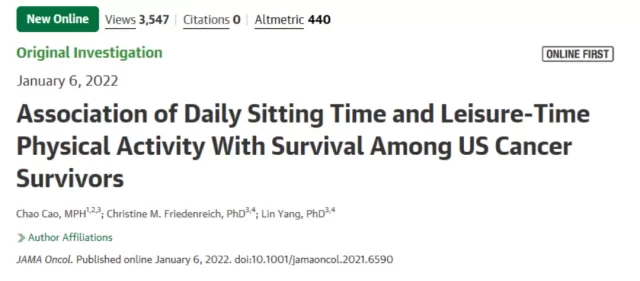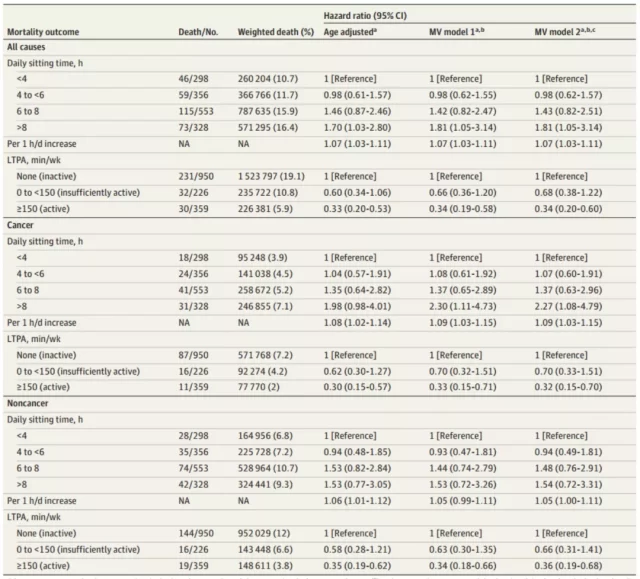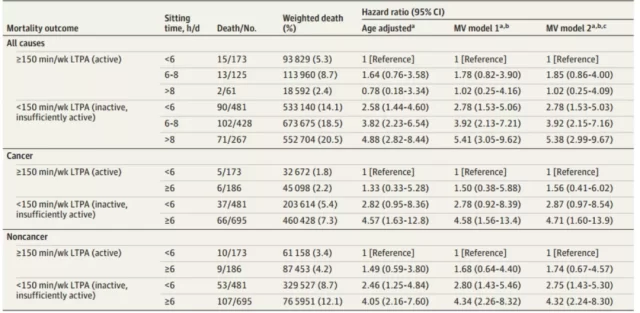Active physical activities in cancer survivors bring 66% lower on risks of all-cause mortality
- Why Lecanemab’s Adoption Faces an Uphill Battle in US?
- Yogurt and High LDL Cholesterol: Can You Still Enjoy It?
- WHO Releases Global Influenza Vaccine Market Study in 2024
- HIV Infections Linked to Unlicensed Spa’s Vampire Facial Treatments
- A Single US$2.15-Million Injection to Block 90% of Cancer Cell Formation
- WIV: Prevention of New Disease X and Investigation of the Origin of COVID-19
Active physical activities in cancer survivors bring 66% lower on risks of all-cause mortality
- Red Yeast Rice Scare Grips Japan: Over 114 Hospitalized and 5 Deaths
- Long COVID Brain Fog: Blood-Brain Barrier Damage and Persistent Inflammation
- FDA has mandated a top-level black box warning for all marketed CAR-T therapies
- Can people with high blood pressure eat peanuts?
- What is the difference between dopamine and dobutamine?
- How long can the patient live after heart stent surgery?
Active physical activities in cancer survivors bring 66% lower on risks of all-cause mortality
Cancer patients should be more active! Up to 9 years of follow-up shows that 2.5 hours of activity per week in cancer patients is associated with a nearly 70% reduction in the risk of all-cause mortality丨Clinical discovery
The number of cancer survivors worldwide has increased substantially due to advances in cancer screening and treatment techniques. Therefore, the prognostic management of cancer survivors is particularly important.
Recently, researchers from the University of Calgary in Canada showed that compared with cancer survivors who lacked physical activity, active physical activity in cancer survivors was associated with a 66% lower risk of all-cause mortality; compared with daily sedentary time For cancer survivors who were less than 6 hours a day, sitting for more than 8 hours a day was associated with an 81% increased risk of all-cause mortality; cancer survivors who were sedentary for more than 8 hours a day and were physically inactive were at the highest risk of death . The findings were published in JAMA Oncology , a top journal in the field of oncology [1].

The global population of cancer survivors is rapidly growing due to technological advances in early cancer screening and treatment, coupled with an aging population [2].
Many cancers and cancer treatments have adverse effects and shorten the life expectancy of cancer patients [3].
Therefore, there is an urgent need to develop actionable strategies to improve the long-term health of cancer survivors.
Physical activity has long been considered a healthy lifestyle, and many studies have shown that physical activity is associated with a reduced risk of common chronic diseases [4] and improved cancer survival rates before and after diagnosis [5].
Physical activity may improve cancer survival through the following three ways: first, it has a direct impact on tumor growth and metastasis, second, it improves the completion rate of treatment, and third, it improves the treatment effect [6].
Evidence suggests that the health effects of physical activity in cancer survivors are more pronounced than before cancer diagnosis [7].
However, cancer survivors have very low levels of physical activity—more than one-third sit for long periods of time with little or no physical activity [8].
In healthy populations, adequate physical activity has been shown to counteract the negative effects of sedentary behavior [9-10].
Cancer survivors may be more likely to be sedentary due to comorbidities and functional deterioration associated with cancer and cancer treatment.
However, epidemiological evidence on the association between sedentary time and physical activity and the risk of death in cancer survivors remains scarce.
Therefore, the main research objective of Yang’s team was to explore the independent and joint associations between sedentary and physical activity in cancer survivors and the risk of all-cause mortality, cancer and non-cancer mortality.
The researchers used data from the National Health and Nutrition Examination Survey (NHANES) cohort of 1,535 cancer survivors, 60.1% of whom were women, with a mean age of 65.1 years.
During a median follow-up of 9.0 years, 293 cancer survivors died, including 114 from cancer, 41 from heart disease, and 138 from other causes.
After adjusting for a range of confounding factors, the findings showed that sedentary sitting for more than 8 hours per day in cancer survivors was associated with an 81% higher risk of all-cause mortality compared with less than 4 hours per day of sitting.
127% increase . Each additional hour of daily sedentary time was associated with a 7% and 9% increased risk of all-cause and cancer death, respectively (Table 1).
 Table 1: Association of sedentary, physical activity and all-cause and specific-cause mortality
Table 1: Association of sedentary, physical activity and all-cause and specific-cause mortality
The researchers divided physical activity into groups, defining more than 150 minutes per week as active physical activity and less than 150 minutes per week as inactive.
The results showed that cancer survivors who were physically active were associated with a 66% lower risk of all-cause death and a 68% lower risk of cancer death compared to the physically inactive group .
These associations were significant in both male and female, obese and non-obese cancer survivors.
The researchers then conducted a stratified analysis of physical activity and found that sedentary behavior was not associated with risk of death among physically active cancer survivors.
However, among those cancer survivors who were physically inactive, longer sedentary behavior was significantly associated with an increased risk of death in a dose-response relationship, with each additional hour of sedentary time associated with an 8% increased risk of all-cause mortality , was also associated with a 9% increased risk of cancer death .
In a joint analysis, the researchers found that compared with cancer survivors who were physically active and sedentary for less than 6 hours, cancer survivors who were physically inactive for more than 8 hours a day had the highest risk of death, with a hazard ratio of 5.38 (95% CI: 2.99-9.67) (Table 2).
The researchers then excluded cancer survivors who died within the 2-year follow-up period and found the same results.
 Table 2: Combined effect of sedentary and physical activity on mortality risk
Table 2: Combined effect of sedentary and physical activity on mortality risk
Finally, Yang’s research team also stated several limitations of the study.
First, sedentary and physical activity information in this study was obtained from patient self-reports, rather than objectively measured by wearable devices; second, sedentary behavior and physical activity were measured at baseline and did not reflect patient behavior during follow-up.
Dynamic changes; finally, NHANES does not collect tumor stage and treatment information from cancer patients, which may create reverse causality.
Overall, in this prospective cohort study of a nationally representative sample of U.S. cancer survivors, investigators found that sedentary and physical inactivity in cancer survivors was associated with an increased risk of all-cause and cancer death.
Future research is needed to elucidate these associations further, and substantial evidence is needed to quantify the timing, dose, restriction, and type of sedentary behavior and physical activity to increase survival among cancer survivors.
References:
[1] Cao C, Friedenreich CM, Yang L. Association of Daily Sitting Time and Leisure-Time Physical Activity With Survival Among US Cancer Survivors [published online ahead of print, 2022 Jan 6]. JAMA Oncol. 2022;10.1001/jamaoncol.2021.6590. doi:10.1001/jamaoncol.2021.6590
[2] Global Burden of Disease Cancer Collaboration, Global Burden of Disease Cancer Collaboration. Global, regional, and national cancer incidence, mortality, years of life lost, years lived with disability, and disability-adjusted life-years for 29 cancer groups, 1990 to 2017: a systematic analysis for the Global Burden of Disease study. JAMA Oncol. 2019;5(12): 1749-1768. doi:10.1001/jamaoncol.2019.2996
[3] Jensen RE, Potosky AL, Moinpour CM, et al. United States Population-Based Estimates of Patient-Reported Outcomes Measurement Information System Symptom and Functional Status Reference Values for Individuals With Cancer. J Clin Oncol. 2017;35(17):1913-1920. doi:10.1200/JCO.2016.71.4410
[4] Janssen I, Clarke AE, Carson V, et al. A systematic review of compositional data analysis studies examining associations between sleep, sedentary behaviour, and physical activity with health outcomes in adults. Appl Physiol Nutr Metab. 2020;45(10 (Suppl. 2)):S248-S257. doi:10.1139/apnm-2020-0160
[5] Friedenreich CM, Stone CR, Cheung WY, Hayes SC. Physical activity and mortality in cancer survivors: a systematic review and meta-analysis. J Natl Cancer Inst Cancer Spectr. 2019;4(1):pkz080. doi:10.1093/jncics/pkz080
[6] Yang L, Morielli AR, Heer E, et al. Effects of Exercise on Cancer Treatment Efficacy: A Systematic Review of Preclinical and Clinical Studies. Cancer Res. 2021;81(19):4889-4895. doi:10.1158/0008-5472.CAN-21-1258
[7] Schmitz KH, Campbell AM, Stuiver MM, et al. Exercise is medicine in oncology: Engaging clinicians to help patients move through cancer. CA Cancer J Clin. 2019;69(6):468-484. doi:10.3322/caac.21579
[8] National Cancer Institute. Cancer survivors and physical activity. 2021. Accessed July 16, 2021. https://progressreport.cancer.gov/after/physical_activity
[9] Biswas A, Oh PI, Faulkner GE, et al. Sedentary time and its association with risk for disease incidence, mortality, and hospitalization in adults: a systematic review and meta-analysis [published correction appears in Ann Intern Med. 2015 Sep 1;163(5):400]. Ann Intern Med. 2015;162(2):123-132. doi:10.7326/M14-1651
[10] Ekelund U, Steene-Johannessen J, Brown WJ, et al. Does physical activity attenuate, or even eliminate, the detrimental association of sitting time with mortality? A harmonised meta-analysis of data from more than 1 million men and women [published correction appears in Lancet. 2016 Sep 24;388(10051):e6]. Lancet. 2016;388(10051):1302-1310. doi:10.1016/S0140-6736(16)30370-1
Active physical activities in cancer survivors bring 66% lower on risks of all-cause mortality
(source:internet, reference only)
Disclaimer of medicaltrend.org
Important Note: The information provided is for informational purposes only and should not be considered as medical advice.



